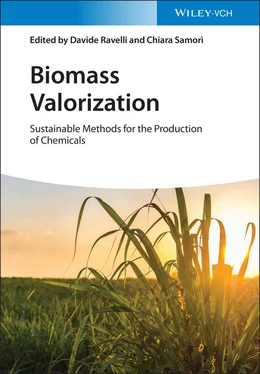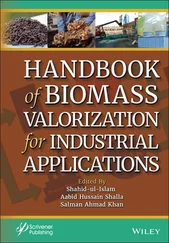Biomass Valorization
Здесь есть возможность читать онлайн «Biomass Valorization» — ознакомительный отрывок электронной книги совершенно бесплатно, а после прочтения отрывка купить полную версию. В некоторых случаях можно слушать аудио, скачать через торрент в формате fb2 и присутствует краткое содержание. Жанр: unrecognised, на английском языке. Описание произведения, (предисловие) а так же отзывы посетителей доступны на портале библиотеки ЛибКат.
- Название:Biomass Valorization
- Автор:
- Жанр:
- Год:неизвестен
- ISBN:нет данных
- Рейтинг книги:3 / 5. Голосов: 1
-
Избранное:Добавить в избранное
- Отзывы:
-
Ваша оценка:
- 60
- 1
- 2
- 3
- 4
- 5
Biomass Valorization: краткое содержание, описание и аннотация
Предлагаем к чтению аннотацию, описание, краткое содержание или предисловие (зависит от того, что написал сам автор книги «Biomass Valorization»). Если вы не нашли необходимую информацию о книге — напишите в комментариях, мы постараемся отыскать её.
Explore the potential of biomass-based chemicals with this comprehensive new reference from leading voices in the field Biomass Valorization: Sustainable Methods for the Production of Chemicals
Biomass Valorization: Sustainable Methods for the Production of Chemicals
Biomass Valorization — читать онлайн ознакомительный отрывок
Ниже представлен текст книги, разбитый по страницам. Система сохранения места последней прочитанной страницы, позволяет с удобством читать онлайн бесплатно книгу «Biomass Valorization», без необходимости каждый раз заново искать на чём Вы остановились. Поставьте закладку, и сможете в любой момент перейти на страницу, на которой закончили чтение.
Интервал:
Закладка:
Although the production of ForA has been substantially improved with commercialization of OxFA process (catalytic oxidation of carbohydrates using a catalyst H 5PV 2Mo 10O 40·35H 2O [100]), LevA and its derivatives remain in the center of the biorefinery research. Some issues that relate to the recovery of the catalyst and products may be resolved by conversions of saccharides in alcohol media instead of water. Such processes generate alkyl levulinates as principal products, which are relatively easy to recover by vacuum distillation [101]. These products may be converted into LevA or are directly used for the production of fuels and other specialty chemicals [ 101, 102]. Lewis acidic metal trifluoromethanesulfonates (metal triflates) and their mixtures with sulfonic acids appeared to be effective and recoverable catalysts, providing high output of methyl levulinate (MLev) during the processing of MCC in methanol [101]. Sulfonic acids presumably improve the reaction rates of the Brønsted acid‐catalyzed cellulose solvolysis into low‐molecular‐weight saccharides, while the metal triflates promote further conversions of saccharides into MLev, likely via Lewis acid‐catalyzed isomerization ( Scheme 2.2) [101]. In combination, these two acids (Brønsted and Lewis) favor the overall cascade of reactions and selectivity of MLev. In(OTf) 3and aromatic sulfonic acids (1 : 5 molar ratio, respectively) provide the highest MLev yield (75 mol%, 180 °C, five hours, Table 2.2).
Our recent study employs an integrated technology comprising consecutive processing of unrefined low‐value cellulose in the DES ChCl/oxalic acid and then in ethanol to form ethyl levulinate (ELev) [ 57, 103]. The first step generates fine cellulosic powder from bulk cellulose during the processing in the DES under mild conditions (80 °C, two hours). The product possesses a structure and properties consistent with MCC [103]. The second step is a high‐temperature transformation (160–180 °C) in ethanol under the action of metal triflates. We discovered that soft Lewis acidic metal triflates form synergistic Lewis acid‐assisted Brønsted acid complexes with phosphoric acid, among which a composition Y(OTf) 3/H 3PO 4(1 : 1 molar ratio, respectively), affording for the highest ELev yield (up to 75 mol%, Table 2.2) [103]. Neither Y(OTf) 3nor H 3PO 4can separately catalyze the conversion of MCC into ELev, and only their combination generates the active catalyst ( Table 2.2). Hard Lewis acids, including In(OTf) 3, show moderate activity in this process, which can be marginally improved in combination with p ‐toluenesulfonic acid (TsOH), as was noted during the conversion of MCC in methanol ( Table 2.2) [101]. Usefully, the conversion of wood‐derived cellulose, obtained after the processing of softwood chips in the biphasic system ChCl/oxalic acid/MIBK ( Table 2.1), as disclosed earlier in the text, enabled similarly excellent conversion thereof into ELev in the presence of a combined acid catalyst Y(OTf) 3/H 3PO 4( Table 2.2) [57]. Such integrated methods that involve different catalytic processes, leading to a range of value‐added chemicals, have significant potential to become commercially viable. Meanwhile, engineering of (preferably) continuous processes requires further laboratory‐ and pilot‐scale research.
Table 2.2 Conditions and results of the acid‐catalyzed processing of cellulosic biomass into organic acids or esters a. Source: Bodachivskyi et al. [ 57, 103].
| Substrate | Catalyst | T (°C) | t (h) | Yield LevA or alkyl levulinates (%) | Yield ForA (%) | Yield LacA or α‐hydroxy acid derivatives (%) | References |
|---|---|---|---|---|---|---|---|
| Paper pulp | H 2SO 4 | 205 185 | 15 (s) 0.42 | 61 (LevA) | 82 | — | [96] |
| MCC | TsOH | 180 | 5 | 20 (MLev) | — | — | [101] |
| In(OTf) 3 | 42 (MLev) | — | — | ||||
| In(OTf) 3/TsOH | 70 (MLev) | — | — | ||||
| In(OTf) 3/NSA | 75 (MLev) | — | — | ||||
| MCC | H 3PO 4 | 160 | 4 | 0 (ELev) | — | — | [103] |
| TsOH | 0 (ELev) | — | — | ||||
| Y(OTf) 3 | 0 (ELev) | — | — | ||||
| Y(OTf) 3/H 3PO 4 | 68 (ELev) | — | — | ||||
| In(OTf) 3 | 20 (ELev) | — | — | ||||
| In(OTf) 3/TsOH | 45 (ELev) | — | — | ||||
| MCC | Y(OTf) 3/H 3PO 4 | 180 | 2 | 75 (ELev) | — | — | |
| Pinus cellulose (unbleached) b | 75 (ELev) | — | — | ||||
| Pinus cellulose b | 73 (ELev) | — | — | ||||
| Softwood | 52 (ELev) | — | — | ||||
| Softwood cellulose c | 62 (ELev) | — | — | [57] | |||
| MCC | Er(OTf) 3 | 240 | 0.5 | 4 (LevA) | 3 | 90 (LacA) | [104] |
| MCC | Ga‐doped Zn/H‐nanozeolite Y | 280 | 1 | 5 (MLev) | — | 58 (MLac) 13 (MMP) | [105] |
| MCC | Zr‐SBA‐15 | 260 | 6 | 2 (ELev) | — | 30 (ELac) 14 (EHB) | [106] |
| Scenedesmus | Sn‐beta | 210 | 2 | 0 | — | 83 (LacA) | [107] |
a)We note that this table shows yields of products either in mol% or in wt%; it is recommended to refer to the given references if the accurate evaluation of yields is sought. “—”, not specified; “0”, not detected, or detected in trace amounts; T , reaction temperature; t , reaction time; MCC, microcrystalline cellulose; OTf, trifluoromethanesulfonate; TsOH, p ‐toluenesulfonic acid; 2‐NSA, 2‐naphthalenesulfonic acid; LevA, levulinic acid; ForA, formic acid; MLev, methyl levulinate; ELev, ethyl levulinate; LacA, lactic acid; MLac, methyl lactate; MMP, methyl 2‐methoxypropanoate; ELac, ethyl lactate; and EHB, ethyl‐2‐hydroxybutanoate.
b)Cellulose treated in the DES ChCl/oxalic acid [103].
c)Cellulose treated in the DES ChCl/oxalic acid/MIBK [57].
Finally, we turn now to the valorization of cellulosic biomass into α‐hydroxy acids. The formation of these products occurs via Lewis acid‐catalyzed retro–aldol transformation of cellulose‐derived monosaccharides into C 2–C 4sugars and sequential retro‐Michael dehydration into pyruvic aldehyde, rehydration, and isomerization into 2‐hydroxy carboxylic acids catalyzed by both Brønsted and Lewis acids ( Scheme 2.2) [ 3, 4, 7]. LacA is usually the desired product of such transformations; however, other derivatives may also appear. The conversion of sugars into LacA requires hydrothermal conditions and Lewis acidic catalysts that remain stable in water at elevated temperature. Metal triflates are water‐tolerant Lewis acids and so are suitable catalysts for the task of hydrothermal conversion of cellulose into products [ 7, 21]. In a study of a series of lanthanide triflates, it has been established that yields of LacA increase with a reduction of the ionic radius of the metal center La 3+< Ce 3+< Pr 3+< Nd 3+< Dy 3+< Ho 3+< Er 3+and is approximately equal for Er 3+≈ Yb 3+≈ Lu 3+ [104]. Among these, Er(OTf) 3was found to be the most active catalyst, providing an outstanding yield of 90 mol% yield of LacA during the reaction of MCC ( Table 2.2) [104]. Importantly, the catalyst may be recovered by distillation of the product and be reused in the next cycle.
Читать дальшеИнтервал:
Закладка:
Похожие книги на «Biomass Valorization»
Представляем Вашему вниманию похожие книги на «Biomass Valorization» списком для выбора. Мы отобрали схожую по названию и смыслу литературу в надежде предоставить читателям больше вариантов отыскать новые, интересные, ещё непрочитанные произведения.
Обсуждение, отзывы о книге «Biomass Valorization» и просто собственные мнения читателей. Оставьте ваши комментарии, напишите, что Вы думаете о произведении, его смысле или главных героях. Укажите что конкретно понравилось, а что нет, и почему Вы так считаете.












